Vapor Audio Cirrus Black Loudspeaker
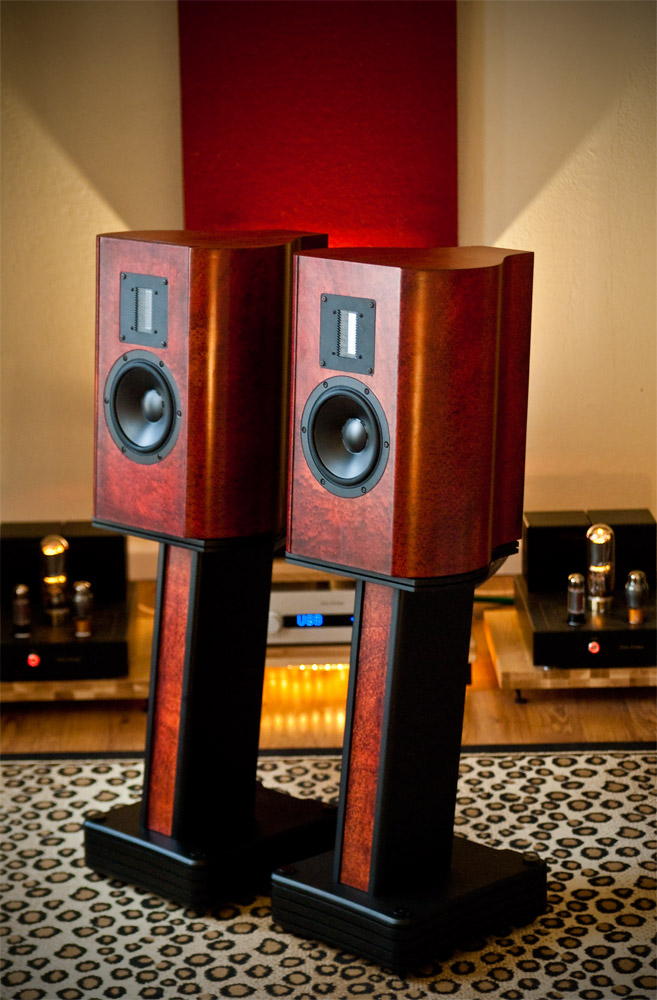
Fancy. Fun and Affordable!
 Pittsburgh is somewhat of a hi-fi black hole. The nearest really serious two-channel dealer is two hours away in Cleveland, and for the average Joe, on the scale of desirable toys to own, high-end audio falls somewhere below a fancy stainless steel beer-miester or a tricked out garden hose reel. That is to say, it’s virtually invisible. I’d be willing to bet that if I visited every house in my plan – over a hundred homes – there would not be another half decent hi-fi to be found. Of course, this isn’t necessarily unique to Pittsburgh, but the vacuum seems particularly acute here because you have to drive so far to find decent equipment. Needless to say, all those dedicated music fans that swear that they can’t go ten minutes without an ear-bud don’t know what they’re missing. A sign of the times, I suppose.
Pittsburgh is somewhat of a hi-fi black hole. The nearest really serious two-channel dealer is two hours away in Cleveland, and for the average Joe, on the scale of desirable toys to own, high-end audio falls somewhere below a fancy stainless steel beer-miester or a tricked out garden hose reel. That is to say, it’s virtually invisible. I’d be willing to bet that if I visited every house in my plan – over a hundred homes – there would not be another half decent hi-fi to be found. Of course, this isn’t necessarily unique to Pittsburgh, but the vacuum seems particularly acute here because you have to drive so far to find decent equipment. Needless to say, all those dedicated music fans that swear that they can’t go ten minutes without an ear-bud don’t know what they’re missing. A sign of the times, I suppose.
Nevertheless, over the years I’ve made friends with a small band of two-channel die-hards in this sonic desert (mostly under the age of fifty, thank you very much). We hang out every few months, listen to music, drink a little beer and enjoy our systems: a few equipment geeks scrounging around for the opportunity to hear some new equipment. So it was unusual and noteworthy for several of us to simultaneously hear a little buzz about a small speaker manufacturer, let alone one from St. Louis. A local fellow had gotten hold of a pair of bookshelf speakers made by Vapor Audio (the Breeze) and couldn’t say enough good things about them. Asking around, some of my friends had also heard of the company, and searching the usual Internet forums turned up some intense conversations and positive comments on other models in the company’s line. My curiosity was piqued, so I reached out to the company’s owner to see if I could arrange a review. With all of the chatter I’d encountered I really expected that someone would have beaten me to the punch, but apparently not. A few months of back and forth conversations with Vapor’s proprietor and arrangements were finally set for a review of the Vapor Audio Cirrus Black stand-mounted two-way loudspeakers.
Vapor Audio is the brainchild of Ryan Scott. Trained as a meteorologist, Scott spent many subsequent years as a motor-sports photographer and then a day trader, so of course it only makes perfect sense that for his fourth act he should become a speaker manufacturer. Over time, he claims, his other avocations got boring so speaker building won out. Stranger tales have surely been told.
The speakers showed up on my doorstep in four large boxes accompanied by an exasperated UPS driver who’d been forced into the dual roles of Sherpa and Yak. Chuffing up the hill with the fourth box he looked like a man about to put in for a desk job. I’d be remiss if I didn’t thank the Gentleman in Brown for not simply throwing the boxes out of the back of the truck as he rolled by. I once saw a driver clean and jerk an 80 lb. amplifier out of the back of a truck, so this guy’s dedication to safe delivery is commendable.
Description
The Cirrus Blacks are pear-shaped (looking down from the top) stand-mounted two-way loudspeaker with a rear facing port. Prices start at $3995, and options like bi-wire and upgraded finishes are reasonable. Capacitor upgrades are also available with prices commensurate with the parts. The review pair did not have any upgrades other than the finish. Construction is stacked Baltic Birch plywood – a la the original Magico Mini – with an “acoustic inversion layer” applied to the inside of the cabinet to help eliminate resonances. The speakers were modeled extensively with computer simulation before a piece of wood was ever touched. The cabinets are double-walled with five integral internal cross braces each measuring 19” high, and all of that is held together with vertical tensioning rods. There’s a lot of lumber in these puppies. The review sample had a single pair of WBT 5-way binding posts positioned at the back of the stands to accept either bananas or spades. I used both types of terminations during the review and found the posts to be easily accessible. The stands contain the crossovers, with an umbilical cable connecting them to the speaker. The stands are optional, in which case the crossovers would be installed inside an added separate chamber attached to the bottom of the cabinet, but I can’t imagine that too many people will buy these without the stands. They are designed to apply 2 degrees of rake to the speaker for time alignment, and they’re aesthetically integrated with the speakers. The drivers are a RAAL ribbon paired with an Audio Technology mid/woofer. Frequency response is a claimed 37 Hz to 38,500 kHz with a sensitivity of 87.5 dB into an 8 Ohm load and a minimum impedance of 5.6 Ohms. They’re advertised as being very tube-friendly. Although they are a stand mounted “monitor” there’s nothing small about the Cirrus Blacks. Each speaker weighs 54 lbs., plus the 35 lb. stands. No puny mini-monitors here.
Finish
One of the things the online peanut gallery consistently noted was the quality of Scott’s cabinetry, with tales of exotic veneers and hand rubbed finishes. The pictures on the Vapor website looked promising, but really don’t do them justice. I concede that I’ve never heard of “Red Flame Box elder” but rest assured, when applied as a veneer it makes for one damned nice looking pair of speakers. The entire exposed surfaces of the speakers are done in book matched panels, and the stands – which are mostly black – have book matched inserts down the front to visually unify them with the cabinets. The review pair was lacquered to a very fine, high-shine, glass-like piano lacquer finish. Scott’s cabinetry is nicer than most of the furniture in my house. Even my wife thought they were pretty, and she generally couldn’t care less about this stuff as long as my equipment doesn’t cross the invisible line that crosses the room at the end of the sofa.
Setup
Setup was easy enough. The speakers bolt securely to the stands using a supplied Allen key. The stands on the review samples were supplied with conical footers that unfortunately were not long or pointy enough to make solid contact with the floor through my carpet. Scott graciously had a pair of longer carpet spikes drop-shipped, and that problem was solved. I do have one minor quibble about the stands: while they’re very heavy and well made, with bases consisting of five stacked layers of MDF, they’re actually slightly narrower and lighter than the speaker cabinets themselves. Once installed, the speakers on top of the stands were a little top-heavy, and I don’t think it would take much effort to push one over. Perhaps I’m just oversensitive to these things because I’ve got a toddler running around the house, but a wider base, or some out riggers, would have given me an extra measure of confidence in their stability. Having said that, I never experienced any problems with instability during the review, especially after the longer spikes were installed, so that could just be a little new-dad paranoia.
Positioning the Cirrus Blacks took a little experimentation but was relatively straightforward. I started by placing them in the same position as my Spendor S8e’s: about three and a half feet from the side walls with the tweeters positioned about five and a half feet from the back wall (the room is 15×18, with the speakers on the short wall). They sounded pretty good from the get-go, but after discussing placement with Scott I ended up with them about a foot further apart and the tweeters only about three feet from the back wall. Moving them closer to the wall reinforced the bass a little. In my room – as I’ve come to expect – toeing them in so the speakers were pointed directly at my listening position provided the best combination of soundstage width and image specificity. I made a few minor adjustments along the way, but that was more or less where they stayed for the balance of their visit. The RAAL tweeter seems to have a fairly wide dispersion pattern, creating an imaging sweet spot that does not require the listener to keep his/her head locked in a vice. I could shift around from side to side in my chair, or even sit off axis in the next chair over, and not completely blow the stereo image. These were very easy speakers to place properly in my room.
Time to fire up these bad boys
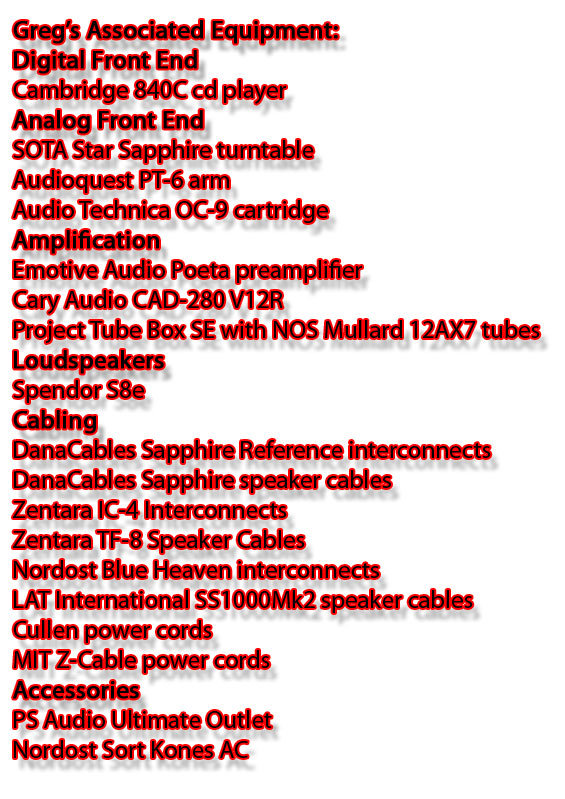 My amplifier – a Cary CAD 280 V12r –has pretty good grunt as tube amplifiers go, with huge transformers that belie its output of between 50 watts in triode and 100 watts in ultra-linear. The only time it’s ever let me down was on a very insensitive (but otherwise really excellent) pair of 85 dB Vandersteen Treos. The V12 series amplifiers were shipped from the factory with EL-34 output tubes, but opinions on which output tubes work the best are as numerous as pigeons in the park. My personal experience has been that KT-77s retain most of the EL-34’s midrange, but offer greater extension top and bottom with a tighter somewhat more modern sound.Throw in an old pair of Amperex EL84 small signal tubes and that’s how it was equipped for this review.
My amplifier – a Cary CAD 280 V12r –has pretty good grunt as tube amplifiers go, with huge transformers that belie its output of between 50 watts in triode and 100 watts in ultra-linear. The only time it’s ever let me down was on a very insensitive (but otherwise really excellent) pair of 85 dB Vandersteen Treos. The V12 series amplifiers were shipped from the factory with EL-34 output tubes, but opinions on which output tubes work the best are as numerous as pigeons in the park. My personal experience has been that KT-77s retain most of the EL-34’s midrange, but offer greater extension top and bottom with a tighter somewhat more modern sound.Throw in an old pair of Amperex EL84 small signal tubes and that’s how it was equipped for this review.
I started running the V12 into the Cirrus Blacks in full ultra-linear mode through the 8-Ohm taps, which according to measurements taken by Stereophile way back in 2004 provides 25.2 dBs of gain. The RAAL tweeter is a 12 Ohm load, and this combination really pushed the treble out in front of the speakers. The soundstage almost sounded like it was sloping downward, back and away from the treble – an odd effect indeed. After some conversation with Scott, and a re-read of the measurements taken on the amplifier during its review, I downshifted the amplifier to 50 watts triode and plugged the speakers into the 4 Ohm taps, reducing the gain significantly. The treble moved back into the soundstage and into a more-or-less even plane with the rest of the sonic elements, though all of it was still placed forward of the speakers. Experimenting further, I changed the amplifier back to 100 watts ultra-linear but continued to use the 4 Ohm taps. In this configuration the treble was a hair more prominent, and perhaps a tad crisper, but the extra power paid off with bass that was tighter and deeper. The overall presentation wasn’t that different from triode, so this seemed to be a good compromise. Using the 4 Ohm taps seemed to have a bigger impact on the sound than the actual output wattage. Scott also says that he can address impedance matching issues by tailoring the crossover, which is good to know. An attenuator for the tweeter could be handy.
Regardless of amplifier configuration, there is no getting around that the Cirrus Blacks have a forward overall presentation. It’s very well integrated and stable, but dramatically different from my Spendors, which soundstage to the rear of the front baffle of the speaker. Just to be sure this wasn’t an anomaly unique to my amplifier we also ran the speakers with a buddy’s solid state PSE Studio IV amplifier (a decent mid-90s performer that can be had for pennies) and found the sound-staging to be essentially the same, providing some confidence that we were driving the Cirrus Blacks in their intended voice range. I’m not suggesting that the forwardness of the soundstage is bad, it’s just very different than what I’m accustomed to hearing in my system. It took a few days, but once I’d grown accustomed to it I never really gave it another thought.
Sound Impressions
I’m just going to state up front that this is a very impressive sounding pair of loudspeakers, especially given their relatively modest price point. In my system they delivered exceptional detail and clarity without sounding eitheroverly bright or clinically dry. Scott claims that many months of computer modeling, as well experimenting with a variety of drivers, went into the creation of these speakers and I don’t doubt it. This is a sonically well-sorted speaker. His efforts have paid off handsomely.
Aside from the forwardness of the soundstage, the very first note I wrote as I started listening to the Cirrus Blacks was, “These things are fast.” There’s no lag, no slop, just instant on/off every time a note starts or the music ends. I’d expected that kind of speed from the ribbon tweeter, but the surprise was that themids and bass were right there with the treble. From the outset it was clear thatwith a quality signal the speed contributes to a very clean, accurate presentation:particularly impressive being driven by a valve amplifier with a reputation for sounding a bit “tubey”.
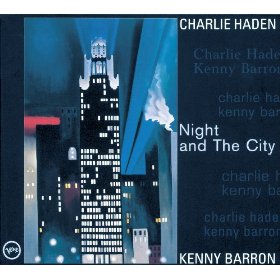 The second note I made was “super-duper resolution.” Listening to Charlie Haden and Kenny Barron’s Night and The City, on just a standard CD, revealed virtually no hash or grit, just a smooth, liquid presentation with space around the instruments and lots of fine details: the timbre of the bass, a chair squeaking, someone in the audience clinking a glass – those little things that can transport the listener from their family room to the recording venue. The resolution also captured spatial cues with an audibly deep soundstage as well as a large, tall image that extends beyond the speaker’s boundaries when the recording requires it.
The second note I made was “super-duper resolution.” Listening to Charlie Haden and Kenny Barron’s Night and The City, on just a standard CD, revealed virtually no hash or grit, just a smooth, liquid presentation with space around the instruments and lots of fine details: the timbre of the bass, a chair squeaking, someone in the audience clinking a glass – those little things that can transport the listener from their family room to the recording venue. The resolution also captured spatial cues with an audibly deep soundstage as well as a large, tall image that extends beyond the speaker’s boundaries when the recording requires it.
The third note I made was “Great bass for a monitor.” The Cirrus Blacks also exhibited surprisingly deep, high-quality bass, staying tight and fully resolved as low as they would go. The aforementioned Charlie Haden CD has prodigious, well-recorded acoustic bass, and not once during listening did I ever hear anything that suggested the speakers were loosing their grip of becoming diffuse. Everything stayed tight as low as they would go.
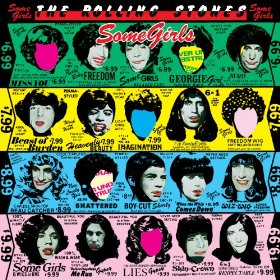 Switching to “Shattered” from the Rolling Stones Some Girls, on vinyl, the Cirrus Blacks got the most of Bill Wyman’s bottom line, which remained distinct and well defined. Charlie Watts’ bass drum had appropriate ‘thump’ with better dynamics than I expected out of stand mounted two-way. The Stones have been written about ad nauseam, but it’s worth mentioning that Watts and Wyman were one of rock and roll’s greatest rhythm sections, and listening to them on a car radio or other middling device it’s easy to miss how tight those two really were in their heyday, and how much groove and drive they put into the music.
Switching to “Shattered” from the Rolling Stones Some Girls, on vinyl, the Cirrus Blacks got the most of Bill Wyman’s bottom line, which remained distinct and well defined. Charlie Watts’ bass drum had appropriate ‘thump’ with better dynamics than I expected out of stand mounted two-way. The Stones have been written about ad nauseam, but it’s worth mentioning that Watts and Wyman were one of rock and roll’s greatest rhythm sections, and listening to them on a car radio or other middling device it’s easy to miss how tight those two really were in their heyday, and how much groove and drive they put into the music.
Of course the Cirrus Blacks are a monitor with a claimed bass limit of 37 Hz. On certain music, if the note was low enough, it rolled off, but for most acoustic music this wasn’t an issue. They also don’t have the slam that comes with bigger drivers moving more air. That’s not to say they don’t have some punch – they definitely do – but they aren’t going to set off the seismograph alarms at the US Geological Survey. That’s the tradeoff you’d expect with a two-way monitor. Still, for most acoustic material, they get the big stuff really right, and when called upon to do so they can rock. I found the bass very satisfying, rarely feeling like I was missing something for the lack of a third driver.
 Different speakers have different characters. The character of the Cirrus Blacks is really defined by the tweeter, which sets the stage for everything else. But the midrange is also exceptional, even if it’s not the first thing that jumps out at you when when you hit ‘play’. On Yelena Eckemov’s Cold Sun, a really a first-rate performance and equally first-rate recording, the piano just sounds tonally right through the entire frequency spectrum with rich chords and distinct resonance on individual notes. One of the great things about this album, musically and mechanically, is that it really makes the most of the frequency spectrum. It’s got deep bass over full two-handed lower-register chords, and there’s a moment during “After Blizzard” where the piano tinkles a swirling cacophonous crescendo in the treble, in duet with the inestimable drummer Peter Erskine. But despite showing off in the extremes, the album lives in the midrange with a constant outpouring of complex chords, melancholy melodies, and sophisticated instrumental interaction. The piano, which has the daunting task of covering the full sonic range, is resonant and rich, and very real sounding. It’s a remarkable CD that I’ve used as a reference for several years, and I’ve rarely heard it sound better than it does through these loudspeakers. (Did I mention that it’s also an outstanding performance? I did? Well let me re-emphasize that point as well.)
Different speakers have different characters. The character of the Cirrus Blacks is really defined by the tweeter, which sets the stage for everything else. But the midrange is also exceptional, even if it’s not the first thing that jumps out at you when when you hit ‘play’. On Yelena Eckemov’s Cold Sun, a really a first-rate performance and equally first-rate recording, the piano just sounds tonally right through the entire frequency spectrum with rich chords and distinct resonance on individual notes. One of the great things about this album, musically and mechanically, is that it really makes the most of the frequency spectrum. It’s got deep bass over full two-handed lower-register chords, and there’s a moment during “After Blizzard” where the piano tinkles a swirling cacophonous crescendo in the treble, in duet with the inestimable drummer Peter Erskine. But despite showing off in the extremes, the album lives in the midrange with a constant outpouring of complex chords, melancholy melodies, and sophisticated instrumental interaction. The piano, which has the daunting task of covering the full sonic range, is resonant and rich, and very real sounding. It’s a remarkable CD that I’ve used as a reference for several years, and I’ve rarely heard it sound better than it does through these loudspeakers. (Did I mention that it’s also an outstanding performance? I did? Well let me re-emphasize that point as well.)
Other qualities worth noting: Even with the forward presentation, the drivers are very well integrated with the transition between the tweeter and the mid-woofer essentially seamless. Even before I optimized my amp to perform with the speakers it was impossible to tell were one driver started and the other began. That’s a pretty good trick considering the speaker mixes driver types. I played a lot of different music on the Cirrus Backs and never caught them out.
The tweeter on its own is an amazing bit of engineering. It’s rated to 38,500 kHz, far beyond what any of us can actually hear, for essentially unlimited treble extension. It also never got fatiguing: no piercing sibilance, and nothing that actually hurt my ears unless it was in the recording itself or if the music was cranked to silly levels.
Finally, for those of you who like to make a lot of noise,the Cirrus Blacks are capable of playing very loud without distorting. We cranked up Us3’s Hand On The Torch to ear-splitting levels and never heard the tweeter or anything else break up. The speaker was able to produce way more sound than our ears could take. Even my next-door neighbor, who favors light beer and country music through a boom box, mentioned that we might have been going overboard. Ha! As if.
Cable Matching
As you might expect with such a high-resolution tweeter, cable changes were immediately audible through the Cirrus Blacks. I have two really good sets of cables on hand: the great, affordable Zentara IC-4 interconnects and matching TF-8 speaker cables, and the really great, and much less affordable Danacables Sapphire Reference ICs and speaker cables.
The Zentaras have a full sound with good detail, great illumination, and a very assured, lively overall presentation. If they were a wine you might describe them as a fruit bomb, with all the elements boldly discernible, but maybe not quite the be-all end-all of integration. Those qualities were all clearly audible through the Cirrus Blacks, but the resolution of the speakers over-matched the cables a little, leaving them to sound a bit hairy-chested, if still quite enjoyable.
To be fair, I might not have noticed this very slight rustic quality at all if I hadn’t also had the DanaCables on hand for comparison. The Sapphires also showed their essential qualities:polite smoothness and resolution, but with a somewhat more concentrated, darker, subtle, and well-sorted presentation. Resolution proved to be the trump card. The RAAL tweeter has such extraordinary detail that as the resolving capabilities of the cables increased the speakers clearly reflected the improvements. There might be limit to the benefits to be had with increasingly higher resolution cables, but I didn’t bump up against it with any of the wires I had on hand.
Of course, I’d be remiss if I didn’t also point out that the DanaCable Sapphire speaker cables cost more than the Cirrus Blackloudspeakers, but I can’t argue with the results. Listeners will naturally have to do a cost-benefit analysis for themselves as they select wires. My advice? Don’t hook up really expensive high-resolution cables to the Cirrus Blacks unless you can afford to buy them. With these speakers you won’t want to go back.
Misadventures in hi-fi
Here’s the part most reviewers rarely admit to. For our most recent hi-fi get-together (the beer was cold and the Stilton was excellent) my friend Emory brought over a 1960-ish vintage Masterwork stereo receiver. It’s an all tube rig that puts out about 15 watts per channel through ECL 86 output tubes. The purpose of including this relic was to do a very unscientific experiment to see how well a low-powered amp could drive the Cirrus Blacks.This particular beast would have most people fetching a fire extinguisher to have on hand just in case, and I’m almost embarrassed to admit that I used it on a pair of speakers that I don’t own. It has no casework, and was originally built with screw taps for the speaker cables. In order to handle today’s spades and bananas Emory had spliced the output wires and terminated them with modern binding posts. Mind you, the posts weren’t actually attached to the chassis. There was some black electrical tape over his solder, and wires, posts, and (I think) the tuner antenna wire were hanging off the back of the amp like a jumble of spaghetti. Oh, and forget about grounding: This thing has a good-old-fashioned captive two-prong plug on lamp cord. I didn’t see any visible evidence of charring so we went ahead and powered it up, butI wouldn’t necessarily recommend that you try this at home. Emory swears that he uses it regularly in his office and that he’d never actually started a fire with it, but reaching over the amp to grab something I got a jolt of electricity up my arm. In the end, I suppose, no harm no foul, but we kept an eye on it while it was running.
Fire hazards notwithstanding, we were really surprised by the results. With only a modest 15 watts the Masterwork had no trouble driving the Cirrus Blacks with as much volume as any sane person would want, and then some. The highs were a little rolled off, which you’d expect from vintage gear, but the mids were wonderful – full, smooth and lush. With only 15 watts we didn’t have great expectations for the bass, but again, we were taken by surprise. The vintage amp didn’t have the control that the Cary has, and as a result the bass lacked some definition and clarity, but the depth and volume were there. Ironically, because the bass wasn’t as well defined it actually created the illusion of having more bass than the other amps. It was a little on the mushy side, but not especially offensive. Low notes sounded more like tones and less the product of actual instruments with unique timbres, so in the end quality trumped quantity and the amps with more damping factor won the day. Still, it was instructive. That Masterworks amp is over fifty years old, and a good one could probably be had for $200 bucks. It isn’t state of the art by any means – hell, we were lucky it didn’t burn the house down – but it was a very satisfying listen. It was one of those hi-fi moments where you wonder how much progress has really been made in the past fifty years.These old amplifiers might not have offered technically accurate reproduction by today’s standards, but some of them sounded really nice.
Of course the point of this little exercise was to ascertain that, indeed, the Cirrus Blacks can be driven to very satisfying levels with only modest power. I didn’t have the opportunity to try it during the review, but I’d be interested in hearing them with something like a mid-powered Shindo amp, or perhaps the 18 watt Lamm ML2.2.As long as the amplifier could adequately control the bass I’ll bet that would be a compelling match. Scott tells me some of his customers happily use them in low-powered systems and I have no reason to doubt him.
Coda
The Cirrus Blacks have extension, resolution, soundstaging, and looks, which brings us to the final and most important question: Do they create an overall satisfying musical experience? In a word: ‘absolutely.’ I’ve had nothing but silk dome tweeters in my system for a decade, so coming into the review I was concerned that the ribbon tweeter would offer speed and resolution at the expense of warmth and musicality, leaving the speaker sounding clinical. Those fears proved totally unfounded. The Cirrus Blacks never sounded thin or bleached in my room, although because of their transparency I suspect that with the wrong electronics they could. That wouldn’t be the speaker’s fault though. You’ll get out of them what you put into them. My equipment is all tubed, but as I mentioned earlier, we also had good results with the solid state amp we tried. Scott himself is using BMC solid state amplifiers at shows, reportedly to great effect. I would only caution that, with a speaker this revealing, make sure you really like the sound of your electronics. With the Cirrus Blacks you’ll know exactly what the rest of your equipment sounds like.
As I’m writing this I’m listening to the excellent 2008 Schema Records CD reissue of Sahib Shihab’s Seeds. Recorded in 1968 by the legendary Wolfgang Hirshmann, Shihab’s baritone saxophone is huge with rich brass vibrato and dynamic scale, the piano is grand and luxurious sounding, and the vibraphone reverberates around the stage. It’s a remarkable recording of terrific music and it sounds great on these speakers.
The Cirrus Blacks really did justice to almost any reasonably well-recorded album or CD. There are bigger, more expensive speakers out there, but don’t count out the little guy. The Vapor Audio Cirrus Blacks are a very serious effort that has yielded a great loudspeaker. If you’re looking in this price range, or even higher, don’t overlook them. They really are something special.


Specifications:
RAAL 70-20XR tweeter
Audio Technology C-Quenze 18H52 woofer
Rear ported, 29hz tuning frequency
Frequency response: 37 – 38,500hz +/- 3db; 45 – 26,000hz +/- 1.5db
Nominal Impedance: 8 ohms
Sensitivity: 87.5db
Recommended power: 15 – 150 watts tube/30-250 watts solid state
Weight: 53 ½ lbs.
19” height x 14” deep x 12.5” max width. 8.25” baffle width
Crossover: Second order parallel network on woofer and tweeter
Crossover point: 2250hz.
Price: starting at $3,995.
Address: 5962 Town and Country Ln House Springs, MO 63051
Phone: 636-375-0086
Email: ryan@vaporsound.com
Website : www.vaporsound.com
One thought on "Vapor Audio Cirrus Black Loudspeaker"
Leave a Reply
Stereo Times Masthead
Publisher/Founder
Clement Perry
Editor
Dave Thomas
Senior Editors
Frank Alles, Mike Girardi, Russell Lichter, Terry London, Moreno Mitchell, Paul Szabady, Bill Wells, Mike Wright, and Stephen Yan,
Current Contributors
David Abramson, Tim Barrall, Dave Allison, Ron Cook, Lewis Dardick, John Hoffman, Dan Secula, Don Shaulis, Greg Simmons, Eric Teh, Greg Voth, Richard Willie, Ed Van Winkle, Rob Dockery, Richard Doran, and Daveed Turek
Site Management Clement Perry
Ad Designer: Martin Perry



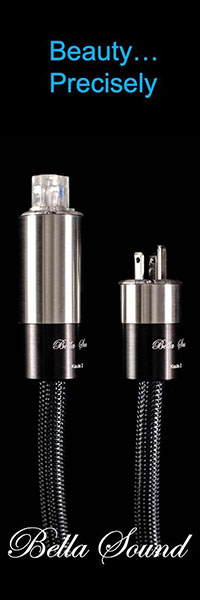

Would you please disclose the sale price of a pair of Vapor Audio Cirrus Black Loudspeaker?
Thank you very much.
Tony
7147255355
tonydo20@yahoo.com